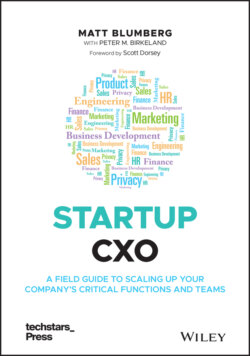Читать книгу Startup CXO - Matt Blumberg - Страница 46
Chief People Officer
ОглавлениеHuman Resources has evolved from transactional, compliance‐focused administrative work to more strategic, proactive work that touches all aspects of the business. The work is much more rewarding and impactful now. This section focuses on the “new HR” which I'll call “People,” and also focuses on a particular framing for People leaders who want to help a CEO and leadership team create a people‐centric, values‐driven, learning organization and culture that optimizes the contribution and experience of employees and their impact to the company. Trust me, as someone who has experienced traditional HR and also worked with CEOs who are only business‐ and not people‐focused, strategically driving a people‐focused company is much more rewarding and impactful. If your founder/CEO has interest in building a values‐driven company, you'll find this Part relevant to your success. I've been lucky to work with Matt at both Return Path and at Bolster, and his mentorship and guidance helped me be more impactful in my People roles, and also expand my impact. At Bolster, I'm working with two sides of our marketplace: members (executives who want to work in on‐demand roles) and clients (CEOs who need to bolster their leadership teams with on‐demand executive talent).
I started my career in a very traditional HR role as the HR Manager at a 100‐person truck stop. I did everything you'd expect in that role including hiring, processing payroll, writing an employee manual, dealing with workers' compensation claims … if it was remotely connected to compliance, I did it. The truck stop was hierarchical, had traditional gender roles, and no one was consulted on any decision since the CEO made all the decisions himself. Although I knew I couldn't thrive there in the long term, I did learn everything about transactional HR that they don't teach you in college, like how to actually run payroll, negotiate benefits, manage difficult employee situations, and manage risk. My role was to focus on the company first, by making sure that we mitigated risk and reduced costs. Many HR people started their careers in similar environments, and, without the benefit of a more open‐minded CEO or company, they become the HR Directors of comic strips.
Luckily, my career shifted after that and I later had the opportunity to work with technology companies whose cultures were focused on people—on trusting that you've hired adults who don't need “managing,” and focused on providing development opportunities for people. At these companies my role was to focus on both the business and on people, and help us make good business decisions that were best for people.
Both business‐first and people‐centric/inclusive companies exist today. If you're an early‐stage startup, and have a CEO who cares deeply about people, help them create a people‐centric/inclusive environment. Building a sustainable company that people love to work for will drive engagement and business results. When someone feels included, and can bring their whole self to work, when they don't have to worry about being judged for having different opinions or ways of working, they do better work. They can focus on the task at hand rather than worrying about what people think, or whether they will be heard if they have an opinion.
At Return Path, we didn't explicitly start with building an inclusive culture. Luckily, the founders and early team members did have a bias toward inclusion and they built a lot of practices and processes that led toward an inclusive environment. At Bolster, we are intentionally building inclusion into our strategy and culture (and in our case, it's related to our actual product offering, too). You'll see people‐centric and inclusive practices throughout this Part that are different from those you've seen at many companies and you'll see how they lead to a more inclusive environment. It's not easy to be inclusive without the support of your CEO since you'll continually have to educate and influence leaders and employees to embrace a different way of working. Having your CEO embrace and lead that education and influence with you is powerful. In my experience, there are more CEOs right now who want to build an inclusive culture than there are HR leaders who have the skills and experience to do this, so the quicker you can embrace the mindset and build the skills required, the more impact you can make at your company and in the world!
Payroll, benefits, and people operations are, of course, urgent in a startup. I'll touch on those later in Chapter 39. These are table stakes and don't highly differentiate you, so I'll start with what I think is your most important role: building an inclusive culture.
As Chief People Officer, you will have far more tasks to complete than time available to you, and I have highlighted the critical things needed to scale: articulating your values, building diversity, equity, and inclusion into your foundation, building your team, setting up structures and practices that lead to the culture you desire, leadership development, recruiting, people operations, onboarding, talent management, organizational design, and team development. Each chapter provides ideas, tools, and issues for the startup and scaleup phases so you can both learn about your current situation and also see what's on the horizon. I realize that the journey from startup to scaleup is not linear and there are times when you need to reduce headcount and I have a chapter on best practices for doing that (Chapter 35).
